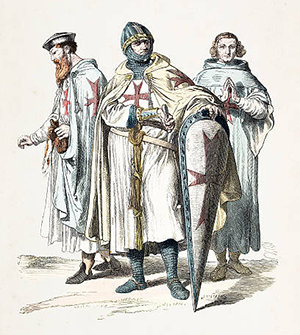The History of Freemasonry
The Freemasons are the oldest and most widely known fraternal organization in the world. Symbolically, the Craft dates back to the days of King Solomon and his building of the first Temple in Jerusalem, as depicted in the Old Testament of the Bible and in the Hebrew Tanakh. The oldest document that makes reference to Masons is the Regius Poem, circa 1425. The illustrious roots of the organization date to when its members were operative Masons who built castles and cathedrals throughout Europe in the Middle Ages. The ritual of the modern fraternity incorporates metaphors of character building with symbolic meaning from architecture, engineering, masonry and construction. It uses the signs and words originally developed by the medieval Masonic guilds as methods of recognition, and the language evolved from a number of sources.
Modern Beginnings
The current organization as we know it today began in the 17th century in Scotland when the stonemasons started to accept members into their lodges who were not members of the Mason's craft – these men were referred to as "speculative Masons" or "accepted Masons". The modern fraternity of Freemasonry officially began with the formation of the first grand lodge in London, England in 1717.
Freemasonry Comes to America
Freemasonry was brought to the United States with our early settlers from England, Scotland and France, and the Craft became very popular in colonial America. Henry Price, a Boston merchant and tailor, received a deputation from the Grand Master of England to form the first Provincial Grand Lodge in the Western Hemisphere in 1733. The fraternity spread throughout the colonies by way of charters carried primarily from England and Scotland, including a number of traveling military lodges that existed at first to serve soldiers, but soon began to confer degrees upon civilians, as well. Even when war with England broke out in America, there were numerous cases of Freemasons on opposing sides of the conflict treating each other with civility and honor.
Our Founding Fathers
Freemasonry had an enormous influence at the time upon the founders of America, as it was a practical and functioning system of democratic governance and administration, toleration of all social classes and religious faiths, with a civilizing influence through the education of its member – all based upon Enlightenment-era philosophies. Of the fifty-six signers of the Declaration of Independence, nine were known to be Masons at the time, and as many as thirty may have been members (or would later join). Among the country's early Masonic leaders were George Washington, Benjamin Franklin, Paul Revere, and John Hancock. Another influential Mason, Chief Justice John Marshall, served as Chief of the Supreme Court for more than thirty-four years and shaped the court into its present form.
Worldwide Charity
In the 1800s, at a time when the U.S. government provided no social "safety net," the Masonic tradition of charity, founding orphanages, homes for widows, and care for the aged provided the only protection many people knew. Over the centuries, Freemasonry has developed into a worldwide fraternity emphasizing personal study, self-improvement, and social betterment by way of individual involvement and philanthropy. The dignity of man, the liberty of the individual, the right of all persons to worship as they choose, and the importance of education stand at the forefront of Masonic thought. Masonic organizations also sponsor an enormous number of official charities around the country and the world, in addition to the millions of dollars contributed by individual Freemasons on their own.
Today
In the 21st century, Freemasons continue their tradition of building bridges of brotherhood as they strive to make good men better ones, and thereby improving the world. Today, there are approximately 3.5 million regular, recognized Freemasons around the globe. Some 1.3 million of them reside in the United States.
New Hampshire Grand Lodge History
The Most Worshipful Grand Lodge of the Ancient and Honorable Fraternity of Free and Accepted Masons of the State of New Hampshire is one of the oldest in the country, it being the 10th one formed in the original colonies. It also has the distinction of being the 14th Grand Lodge to be formed, world-wide. On July 8, 1789, five Freemasons met on the third floor of the William Pitt Tavern in Portsmouth, NH for the purpose of agreeing on the creation of a Grand Lodge for the state. Those in attendance were Brothers Hall Jackson, Joseph Bass, Nathaniel Folsom and Nathaniel Adams from St. John's Lodge in Portsmouth, and Brother Alpheus Moore from Rising Sun Lodge in Keene, NH. At this meeting, they formed the Grand Lodge of New Hampshire, elected John Sullivan as the Grand Master, and subsequently held the first communication on July 16, 1789.
Thus was the Grand Lodge formed. However, there was an immediate issue which needed to be rectified. Grand Master-elect John Sullivan had never been a Master of a lodge – one of the immutable requirements to be Grand Master. Recognizing this and reacting quickly, his Lodge (St. John's of Portsmouth) elected and installed him as Worshipful Master and on April 8, 1790 he was duly installed as the first Grand Master of the Grand Lodge of New Hampshire.
The immediate work of the new Grand Lodge was to contact all other lodges within its jurisdiction and encourage them to recognize the jurisdictional authority of the Grand Lodge. This was accomplished over a period of many years, and as new lodges were formed and petitioned the Grand Lodge for charters, the foundation for Freemasonry within the state became strong.
Although there are many Freemasons living in New Hampshire who moved here from other jurisdictions (and therefore do not show up on the registers of the Grand Lodge) as of January 2019 there were 5,088 registered Freemasons belonging to Lodges within the jurisdiction of the Grand Lodge of New Hampshire, distributed among 58 Regular Lodges and 4 Special Lodges.

